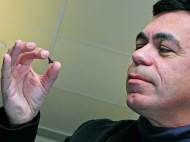Ferropaper – low-cost technology for small motors and robots
 After writing about ferrofluid sculptures and Stanford scientists that combined carbon nanotubes and paper, in this article we’re going to write about researchers at Purdue University who have created a magnetic ferropaper. The material is made by impregnating ordinary paper (even newsprint) with a mixture of mineral oil and “magnetic nanoparticles” of iron oxide. The nanoparticle-laden paper can then be moved using a magnetic field.
After writing about ferrofluid sculptures and Stanford scientists that combined carbon nanotubes and paper, in this article we’re going to write about researchers at Purdue University who have created a magnetic ferropaper. The material is made by impregnating ordinary paper (even newsprint) with a mixture of mineral oil and “magnetic nanoparticles” of iron oxide. The nanoparticle-laden paper can then be moved using a magnetic field.
“Paper is a porous matrix, so you can load a lot of this material into it,” said Babak Ziaie, a professor of electrical and computer engineering and biomedical engineering. “Because paper is very soft it won’t damage cells or tissue,” Ziaie said. “It is very inexpensive to make. You put a droplet on a piece of paper, and that is your actuator, or motor.”
Once saturated with this ferrofluid mixture, the paper is coated with a biocompatible plastic film, which makes it water resistant, prevents the fluid from evaporating and improves mechanical properties such as strength, stiffness and elasticity.
The magnetic particles, which are commercially available, have a diameter of about 10 nanometers, or billionths of a meter, which is roughly 1/10,000th the width of a human hair. Ferro is short for ferrous, or related to iron.
“You wouldn’t have to use nanoparticles, but they are easier and cheaper to manufacture than larger-size particles,” Ziaie said. “They are commercially available at very low cost.”
The researchers used an instrument called a field-emission scanning electron microscope to study how well the nanoparticle mixture impregnates certain types of paper and came to a conclusion that all types of paper can be used, but newspaper and soft tissue paper are especially suitable because they have good porosity.
The researchers fashioned the material into a small cantilever, a structure resembling a diving board that can be moved or caused to vibrate by applying a magnetic field. They also experimented with other shapes and structures resembling Origami to study more complicated movements.
“Cantilever actuators are very common, but usually they are made from silicon, which is expensive and requires special cleanroom facilities to manufacture,” Ziaie said. “So using the ferropaper could be a very inexpensive, simple alternative. This is like 100 times cheaper than the silicon devices now available.”
The new technique represents a low-cost way to make small stereo speakers, miniature robots or motors for a variety of potential applications, including tweezers to manipulate cells and flexible fingers for minimally invasive surgery. Since the technique is inexpensive and doesn’t require specialized laboratory facilities, it could be used in community colleges and high schools to teach about micro robots and other engineering and scientific principles.









Leave your response!